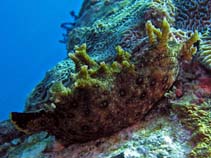Aplysia dactylomela Rang, 1828
Black spotted seahare| Native range | All suitable habitat | Point map | Year 2050 |

|
| This map was computer-generated and has not yet been reviewed. |
| Aplysia dactylomela AquaMaps Data sources: GBIF OBIS |
Classification / Names Common names | Synonyms | CoL | ITIS | WoRMS
| Aplysiida | Aplysiidae
Environment: milieu / climate zone / depth range / distribution range Ekologi
; kisaran kedalaman 0 - 20 m (Ref. 7727). Tropical; 32°N - 24°N, 97°E - 25°E (Ref. 83435)
Penyebaran Negara-negara | Daerah-daerah FAO | Ecosystems | Kemunculan | Introduksi
Circumglobal in tropical and temperate warm seas and introduced in the Mediterranean.
Length at first maturity / Size / Weight / umur
Maturity: Lm ? range ? - ? cm Max length : 41.0 cm TL jantan/; (Ref. 126605); Berat maksimum terpublikasi: 1.4 kg (Ref. 126605); Umur maksimum dilaporkan: 1.00 Tahun (Ref. 126605)
Sea hares have annual life cycles (Ref. 126605). Common on tidal platforms of mixed sand and rock; actively crawling in tide pools at night and in crevices and under rocks during the day (Ref. 866). Grazes on various types of green algae (Ref. 844). Found in warm seas (Ref. 822). Known from depths of 0 to 20 m (Ref. 7727); from low intertidal to immediate subtidal on alga-covered reefs (Ref. 337). Ejecting ink as a predator deterrence and to send alarm signals to conspecifics, but not all spotted sea hares have ink (Ref. 84419). Ink components are based on the chemical properties of their diet (Ref. 84420). Ascorhynchus sp. found parasitic on the gills of this nudibranch (Ref. 121217).
Life cycle and mating behavior Kematangan | Reproduksi, perkembang biakan | Pemijahan | telur-telur | Fecundity | Larva
Members of the order Anaspidea are mostly simultaneous hermaphrodites.
rujukan utama
Acuan | Koordinator | mitra
Debelius, H. 2001. (Ref. 844)
Status IUCN Red List (Ref. 130435)
status CITES (Ref. 108899)
Not Evaluated
CMS (Ref. 116361)
Not Evaluated
ancaman kepada manusia
penggunaan manusia
| FishSource |
Alat, peralatan
informasi lanjut
Nama-nama umum
Sinonim (persamaan)
Pemangsa
Reproduksi, perkembang biakan
Kematangan
Pemijahan
Fecundity
telur-telur
pekembangan telor
Sinonim (persamaan)
Pemangsa
Reproduksi, perkembang biakan
Kematangan
Pemijahan
Fecundity
telur-telur
pekembangan telor
Sumber internet
BHL | BOLD Systems | CISTI | DiscoverLife | FAO(Publication : search) | Fishipedia | GenBank (genom, Nukleotida) | GloBI | Gomexsi | Google Books | Google Scholar | Google | PubMed | Tree of Life | Wikipedia (pergi, Cari) | Zoological Record
Estimates based on models
Preferred temperature
(Ref. 115969): 20.2 - 26.8, mean 24.6 (based on 196 cells).
kategori harga
(Ref. 80766):
Unknown.



